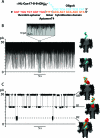Protein detection by nanopores equipped with aptamers
- PMID: 22229655
- PMCID: PMC3278221
- DOI: 10.1021/ja2105653
Protein detection by nanopores equipped with aptamers
Abstract
Protein nanopores have been used as stochastic sensors for the detection of analytes that range from small molecules to proteins. In this approach, individual analyte molecules modulate the ionic current flowing through a single nanopore. Here, a new type of stochastic sensor based on an αHL pore modified with an aptamer is described. The aptamer is bound to the pore by hybridization to an oligonucleotide that is attached covalently through a disulfide bond to a single cysteine residue near a mouth of the pore. We show that the binding of thrombin to a 15-mer DNA aptamer, which forms a cation-stabilized quadruplex, alters the ionic current through the pore. The approach allows the quantification of nanomolar concentrations of thrombin, and provides association and dissociation rate constants and equilibrium dissociation constants for thrombin·aptamer interactions. Aptamer-based nanopores have the potential to be integrated into arrays for the parallel detection of multiple analytes.
Figures





References
-
- Bayley H.; Martin C. R. Chem. Rev. 2000, 100, 2575–2594. - PubMed
-
- Bayley H.; Cremer P. S. Nature 2001, 413, 226–230. - PubMed
-
- Dekker C. Nat. Nanotechnol. 2007, 2, 209–15. - PubMed
-
- Sexton L. T.; Horne L. P.; Martin C. R. Mol. Biosyst. 2007, 3, 667–85. - PubMed
-
- Howorka S.; Siwy Z. Chem. Soc. Rev. 2009, 38, 2360–84. - PubMed
Publication types
MeSH terms
Substances
Grants and funding
LinkOut - more resources
Full Text Sources
Other Literature Sources
Miscellaneous

